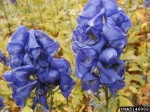 In late summer I look for tall plants with blue flowers borne in spikes and monkshood is one of the best. The deep violet blue color is striking and the flower shape is one of the most interesting in the garden. The deeply lobed, dark green leathery foliage is an asset from the time it emerges from the ground in the spring. The whole plant is considered poisonous but bees and butterflies love them. It is a fine cut flower.
In late summer I look for tall plants with blue flowers borne in spikes and monkshood is one of the best. The deep violet blue color is striking and the flower shape is one of the most interesting in the garden. The deeply lobed, dark green leathery foliage is an asset from the time it emerges from the ground in the spring. The whole plant is considered poisonous but bees and butterflies love them. It is a fine cut flower.
Type: Herbaceous perennial.
Bloom: Late summer to mid fall.
Size: 35-50” H x 1’ W.
Light: Partial shade.
Soil: Moist, cool, fertile soil; sandy loam to some clay; pH 6-7.5.
Hardiness: Zones 4-8.
Pests and Diseases: Aphids.
Propagation: Divide the tuberous roots in late autumn every few years to keep the plants vigorous and flowering well.
Companion Plants: Yellow leaved meadowsweet (Filipendula ulmaria ‘Aurea’), knotweed (Persicaria amplexicaule ‘Taurus’), chrysantemum ‘Cottage Apricot’, daisy (Leucanthemella serotina), and black snakeroot (Actaea racemosa).

I like them, though some people panic and dig them up because they are poisonous. Mine is trouble free and the feathery foliage is a nice contrast for the flowers. I’s quite like to get a white one too.
I’ve never had any problem with pets or kids going near my Monkshood especially since it is more a mid or back of the border plant border plant rather than near the front. A white one? Sounds fabulous!
Karen